Zhou dynasty
| Zhou
周 | |||||||||
|---|---|---|---|---|---|---|---|---|---|
| c. 1046 BC–256 BC | |||||||||
 Population concentration and boundaries of the Western Zhou dynasty (1050–771 BC) in China | |||||||||
| Capital |
| ||||||||
| Common languages | Old Chinese | ||||||||
| Religion | Chinese folk religion, Ancestor worship, Heaven worship[2] | ||||||||
| Government | Monarchy | ||||||||
| King | |||||||||
• c. 1046–1043 BC | King Wu | ||||||||
• 781–771 BC | King You | ||||||||
• 770–720 BC | King Ping | ||||||||
• 314–256 BC | King Nan | ||||||||
| Chancellor | |||||||||
| History | |||||||||
| c. 1046 BC | |||||||||
| 841–828 BC | |||||||||
• Relocation to Wangcheng | 771 BC | ||||||||
| 256 BC | |||||||||
• Fall of the last Zhou holdouts[3] | 249 BC | ||||||||
| Population | |||||||||
• 273 BC | 30,000,000 | ||||||||
• 230 BC | 38,000,000 | ||||||||
| Currency | Mostly spade coins and knife coins | ||||||||
| |||||||||
| Today part of | China | ||||||||
| Zhou dynasty | |||||||||||||||||||||||||||||||||||
|
"Zhou" in ancient bronze script (top), seal script (middle), and regular (bottom) Chinese characters | |||||||||||||||||||||||||||||||||||
| Chinese | 周 | ||||||||||||||||||||||||||||||||||
|---|---|---|---|---|---|---|---|---|---|---|---|---|---|---|---|---|---|---|---|---|---|---|---|---|---|---|---|---|---|---|---|---|---|---|---|
| |||||||||||||||||||||||||||||||||||
 | |||||||
|---|---|---|---|---|---|---|---|
| ANCIENT | |||||||
| Neolithic c. 8500 – c. 2070 BC | |||||||
| Xia dynasty c. 2070 – c. 1600 BC | |||||||
| Shang dynasty c. 1600 – c. 1046 BC | |||||||
| Zhou dynasty c. 1046 – 256 BC | |||||||
| Western Zhou | |||||||
| Eastern Zhou | |||||||
| Spring and Autumn | |||||||
| Warring States | |||||||
| IMPERIAL | |||||||
| Qin dynasty 221–206 BC | |||||||
| Han dynasty 206 BC – 220 AD | |||||||
| Western Han | |||||||
| Xin dynasty | |||||||
| Eastern Han | |||||||
| Three Kingdoms 220–280 | |||||||
| Wei, Shu and Wu | |||||||
| Jin dynasty 265–420 | |||||||
| Western Jin | |||||||
| Eastern Jin | Sixteen Kingdoms | ||||||
| Northern and Southern dynasties 420–589 | |||||||
| Sui dynasty 581–618 | |||||||
| Tang dynasty 618–907 | |||||||
| (Second Zhou dynasty 690–705) | |||||||
| Five Dynasties and Ten Kingdoms 907–960 |
Liao dynasty 907–1125 | ||||||
| Song dynasty 960–1279 |
|||||||
| Northern Song | Western Xia | ||||||
| Southern Song | Jin | ||||||
| Yuan dynasty 1271–1368 | |||||||
| Ming dynasty 1368–1644 | |||||||
| Qing dynasty 1644–1912 | |||||||
| MODERN | |||||||
| Republic of China 1912–1949 | |||||||
| People's Republic of China 1949–present | |||||||
The Zhou dynasty or the Zhou Kingdom (Chinese: 周朝; pinyin: Zhōu cháo [ʈʂóu ʈʂʰǎu]) was a Chinese dynasty that followed the Shang dynasty and preceded the Qin dynasty. The Zhou dynasty lasted longer than any other dynasty in Chinese history. The military control of China by the royal house, surnamed Ji (Chinese: 姬; pinyin: Jī [tɕí]), lasted initially from 1046 until 771 BC for a period known as the Western Zhou and the political sphere of influence it created continued well into Eastern Zhou for another 500 years.
During the Zhou Dynasty, centralized power decreased throughout the Spring and Autumn period until the Warring States period in the last two centuries of the Zhou Dynasty. In this period, the Zhou court had little control over its constituent states that were at war with each other until the Qin state consolidated power and formed the Qin dynasty in 221 BC. The Zhou Dynasty had formally collapsed only 35 years earlier, although the dynasty had only nominal power at that point.
This period of Chinese history produced what many consider the zenith of Chinese bronze-ware making. The dynasty also spans the period in which the written script evolved into its almost-modern form with the use of an archaic clerical script that emerged during the late Warring States period.
History
Foundation
Traditional myth
According to Chinese mythology, the Zhou lineage began when Jiang Yuan, a consort of the legendary Emperor Ku, miraculously conceived a child, Qi "the Abandoned One", after stepping into the divine footprint of Shangdi.[4][5] Qi was a culture hero credited with surviving three abandonments by his mother and with greatly improving Xia agriculture,[4] to the point where he was granted lordship over Tai and the surname Ji by his own Xia king and a later posthumous name, Houji "Lord of Millet", by the Tang of Shang. He even received sacrifice as a harvest god. The term Hòujì was probably a hereditary title attached to a lineage.
Qi's son, or rather that of the Hòujì, Buzhu is said to have abandoned his position as Agrarian Master (Chinese: 農師; pinyin: Nóngshī) in old age and either he or his son Ju abandoned agriculture entirely, living a nomadic life in the manner of the Xirong and Rongdi (see Hua–Yi distinction).[6] Ju's son Liu,[7] however, led his people to prosperity by restoring agriculture and settling them at a place called Bin,[lower-alpha 3] which his descendants ruled for generations. Tai later led the clan from Bin to Zhou, an area in the Wei River valley of modern-day Qishan County.
The duke passed over his two elder sons Taibo and Zhongyong to favor Jili, a warrior who conquered several Xirong tribes as a vassal of the Shang kings Wu Yi and Wen Ding before being treacherously killed. Taibo and Zhongyong had supposedly already fled to the Yangtze delta, where they established the state of Wu among the tribes there. Jili's son Wen bribed his way out of imprisonment and moved the Zhou capital to Feng (within present-day Xi'an). Around 1046 BC, Wen's son Wu and his ally Jiang Ziya led an army of 45,000 men and 300 chariots across the Yellow River and defeated King Zhou of Shang at the Battle of Muye, marking the beginning of the Zhou dynasty.[lower-alpha 4] The Zhou enfeoffed a member of the defeated Shang royal family as the Duke of Song, which was held by descendants of the Shang royal family until its end. This practice was referred to as Two Kings, Three Reverences.
Culture
According to Nicholas Bodman, the Zhou appear to have spoken a language not basically different in vocabulary and syntax from that of the Shang.[lower-alpha 5] A recent study by David McCraw, using lexical statistics, reached the same conclusion.[10] The Zhou emulated extensively Shang cultural practices, perhaps to legitimize their own rule,[11] and became the successors to Shang culture.[12] At the same time, the Zhou may also have been connected to the Xirong, a broadly defined cultural group to the west of the Shang, which the Shang regarded as tributaries.[13] According to the historian Li Feng, the term "Rong" during the Western Zhou period was likely used to designate political and military adversaries rather than cultural and ethnic 'others.'[12]
Western Zhou
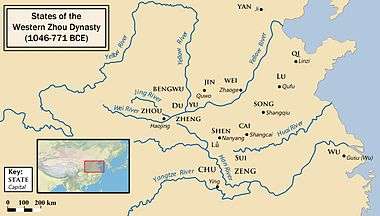
King Wu maintained the old capital for ceremonial purposes but constructed a new one for his palace and administration nearby at Hao. Although Wu's early death left a young and inexperienced heir, the Duke of Zhou assisted his nephew King Cheng in consolidating royal power. Wary of the Duke of Zhou's increasing power, the "Three Guards", Zhou princes stationed on the eastern plain, rose in rebellion against his regency. Even though they garnered the support of independent-minded nobles, Shang partisans and several Dongyi tribes, the Duke of Zhou quelled the rebellion, and further expanded the Zhou Kingdom into the east.[14][15][16] To maintain Zhou authority over its greatly expanded territory and prevent other revolts, he set up the fengjian system.[15] Furthermore, he countered Zhou's crisis of legitimacy by expounding the doctrine of the Mandate of Heaven while accommodating important Shang rituals at Wangcheng and Chengzhou.[17]
Over time, this decentralized system became strained as the familial relationships between the Zhou kings and the regional dynasties thinned over the generations. Peripheral territories developed local power and prestige on par with that of the Zhou.[18] When King You demoted and exiled his Jiang queen in favor of the beautiful commoner Bao Si, the disgraced queen's father the Marquis of Shen joined with Zeng and the Quanrong barbarians to sack Hao in 771 BC. Some modern scholars have surmised that the sack of Haojing might have been connected to a Scythian raid from the Altai before their westward expansion.[19] With King You dead, a conclave of nobles met at Shen and declared the Marquis's grandson King Ping. The capital was moved eastward to Wangcheng,[1] marking the end of the "Western Zhou" (西周, p Xī Zhōu) and the beginning of the "Eastern Zhou" dynasty (东周, p Dōng Zhōu).
Eastern Zhou

The Eastern Zhou was characterized by an accelerating collapse of royal authority, although the king's ritual importance allowed over five more centuries of rule. The Confucian chronicle of the early years of this process led to its title of the "Spring and Autumn" period. The partition of Jin in the mid-5th century BC initiated a second phase, the "Warring States".[18] In 403 BC, the Zhou court recognized Han, Zhao, and Wei as fully independent states. Duke Hui of Wei, in 344 BC, was the first to claim the royal title of king (Chinese: 王) for himself. Others followed, marking a turning point, as rulers did not even entertain the pretence of being vassals of the Zhou court, instead proclaiming themselves fully independent kingdoms. A series of states rose to prominence before each falling in turn, and Zhou was a minor player in most of these conflicts.
The last Zhou king is traditionally taken to be Nan, who was killed when Qin captured the capital Wangcheng[1] in 256 BC. A "King Hui" was declared, but his splinter state was fully removed by 249 BC. Qin's unification of China concluded in 221 BC with Qin Shihuang's annexation of Qi.
The Eastern Zhou, however, is also remembered as the golden age of Chinese philosophy: the Hundred Schools of Thought which flourished as rival lords patronized itinerant shi scholars is led by the example of Qi's Jixia Academy. The Nine Schools of Thought which came to dominate the others were Confucianism (as interpreted by Mencius and others), Legalism, Taoism, Mohism, the utopian communalist Agriculturalism, two strains of Diplomatists, the sophistic Logicians, Sun-tzu's Militarists, and the Naturalists.[20] Although only the first three of these went on to receive imperial patronage in later dynasties, doctrines from each influenced the others and Chinese society in sometimes unusual ways. The Mohists, for instance, found little interest in their praise of meritocracy but much acceptance for their mastery of defensive siege warfare; much later, however, their arguments against nepotism were used in favor of establishing the imperial examination system.
Culture and society
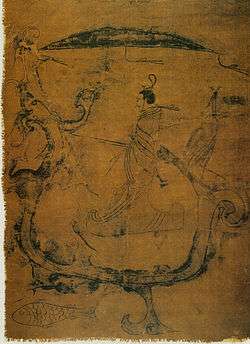
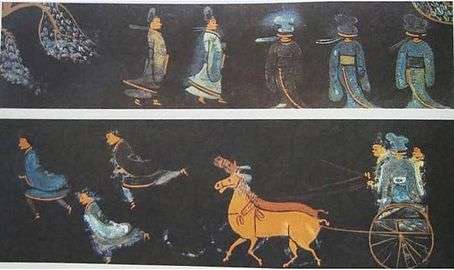
Mandate of Heaven and the Justification of Power
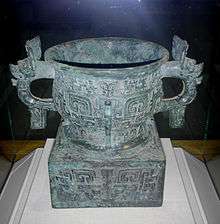
Zhou rulers introduced what was to prove one of East Asia's most enduring political doctrines. The concept of the "Mandate of Heaven". They did this so by asserting that their moral superiority justified taking over Shang wealth and territories, also that heaven had imposed a moral mandate on them to replace the Shang and return good governance to the people.[21]
The Mandate of Heaven was presented as a religious compact between the Zhou people and their supreme god in heaven (literally the 'sky god'). The Zhou agreed that since worldly affairs were supposed to align with those of the heavens, the heavens conferred legitimate power on only one person, the Zhou ruler. In return, the ruler was duty-bound to uphold heaven's principles of harmony and honor. Any ruler who failed in this duty, who let instability creep into earthly affairs, or who let his people suffer, would lose the mandate. Under this system, it was the prerogative of spiritual authority to withdraw support from any wayward ruler and to find another, more worthy one.[22] In this way, the Zhou sky god legitimated regime change.
In using this creed, the Zhou rulers had to acknowledge that any group of rulers, even they themselves, could be ousted if they lost the mandate of heaven because of improper practices. The book of odes written during the Zhou period clearly intoned this caution.[21]
The early Zhou kings contended that heaven favored their triumph because the last Shang kings had been evil men whose policies brought pain to the people through waste and corruption. After the Zhou came to power, the mandate became a political tool.
One of the duties and privileges of the king was to create a royal calendar. This official document defined times for undertaking agricultural activities and celebrating rituals. But unexpected events such as solar eclipses or natural calamities threw the ruling house's mandate into question. Since rulers claimed that their authority came from heaven, the Zhou made great efforts to gain accurate knowledge of the stars and to perfect the astronomical system on which they based their calendar.[22]
Zhou legitimacy also arose indirectly from Shang material culture through the use of bronze ritual vessels, statues, ornaments, and weapons.[22] As the Zhou emulated the Shang's large scale production of ceremonial bronzes, they developed an extensive system of bronze metal working that required a large force of tribute labor. Many of its members were Shang, who were sometimes forcibly transported to new Zhou to produce the bronze ritual objects which were then sold and distributed across the lands, symbolizing Zhou legitimacy.[21]
Feudalism
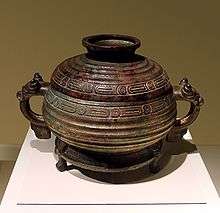
Western writers often describe the Zhou period as "feudal" because the Zhou's fēngjiàn (封建) system invites comparison with medieval rule in Europe.
There were many similarities between the decentralized systems. When the dynasty was established, the conquered land was divided into hereditary fiefs (諸侯, zhūhóu) that eventually became powerful in their own right. In matters of inheritance, the Zhou dynasty recognized only patrilineal primogeniture as legal.[23][24] According to Tao (1934: 17–31), "the Tsung-fa or descent line system has the following characteristics: patrilineal descent, patrilineal succession, patriarchate, sib-exogamy, and primogeniture"[25]
The system, also called "extensive stratified patrilineage", was defined by the anthropologist Kwang-chih Chang as "characterized by the fact that the eldest son of each generation formed the main of line descent and political authority, whereas the younger brothers were moved out to establish new lineages of lesser authority. The farther removed, the lesser the political authority". Ebrey defines the descent-line system as follows: "A great line (ta-tsung) is the line of eldest sons continuing indefinitely from a founding ancestor. A lesser line is the line of younger sons going back no more than five generations. Great lines and lesser lines continually spin off new lesser lines, founded by younger sons".
K.E. Brashier writes in his book "Ancestral Memory in Early China" about the tsung-fa system of patrilineal primogeniture: "The greater lineage, if it has survived, is the direct succession from father to eldest son and is not defined via the collateral shifts of the lesser lineages. In discussions that demarcate between trunk and collateral lines, the former is called a zong and the latter a zu, whereas the whole lineage is dubbed the shi. [...] On one hand every son who is not the eldest and hence not heir to the lineage territory has the potential of becoming a progenitor and fostering a new trunk lineage (Ideally he would strike out to cultivate new lineage territory). [...] According to the Zou commentary, the son of heaven divided land among his feudal lords, his feudal lords divided land among their dependent families and so forth down the pecking order to the officers who had their dependent kin and the commoners who "each had his apportioned relations and all had their graded precedence""[26]
This type of unilineal descent-group later became the model of the Korean family through the influence of Neo-Confucianism, as Zhu Xi and others advocated its re-establishment in China.[27]
Fēngjiàn system and bureaucracy
There were five peerage ranks below the royal ranks, in descending order with common English translations: gōng 公 "duke", hóu 侯 "marquis", bó 伯 "count", zǐ 子 "viscount", and nán 男 "baron".[28] At times, a vigorous duke would take power from his nobles and centralize the state. Centralization became more necessary as the states began to war among themselves and decentralization encouraged more war. If a duke took power from his nobles, the state would have to be administered bureaucratically by appointed officials.
Despite these similarities, there are a number of important differences from medieval Europe. One obvious difference is that the Zhou ruled from walled cities rather than castles. Another was China's distinct class system, which lacked an organized clergy but saw the Shang Zi-clan yeomen become masters of ritual and ceremony known as Shi (士). When a dukedom was centralized, these people would find employment as government officials or officers. These hereditary classes were similar to Western knights in status and breeding, but like Western clergy were expected to be something of a scholar instead of a warrior. Being appointed, they could move from one state to another. Some would travel from state to state peddling schemes of administrative or military reform. Those who could not find employment would often end up teaching young men who aspired to official status. The most famous of these was Confucius, who taught a system of mutual duty between superiors and inferiors. In contrast, the Legalists had no time for Confucian virtue and advocated a system of strict laws and harsh punishments. The wars of the Warring States were finally ended by the most legalist state of all, Qin. When the Qin dynasty fell and was replaced by the Han dynasty, many Chinese were relieved to return to the more humane virtues of Confucius.
Agriculture
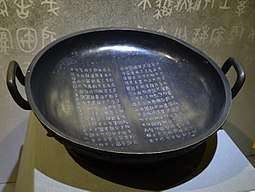
Agriculture in the Zhou dynasty was very intensive and, in many cases, directed by the government. All farming lands were owned by nobles, who then gave their land to their serfs, a situation similar to European feudalism. For example, a piece of land was divided into nine squares in the well-field system, with the grain from the middle square taken by the government and that of surrounding squares kept by individual farmers. This way, the government was able to store surplus food and distribute it in times of famine or bad harvest. Some important manufacturing sectors during this period included bronze smelting, which was integral to making weapons and farming tools. Again, these industries were dominated by the nobility who directed the production of such materials.
China's first projects of hydraulic engineering were initiated during the Zhou dynasty, ultimately as a means to aid agricultural irrigation. The chancellor of Wei, Sunshu Ao, who served King Zhuang of Chu, dammed a river to create an enormous irrigation reservoir in modern-day northern Anhui province. For this, Sunshu is credited as China's first hydraulic engineer. The later Wei statesman Ximen Bao, who served Marquis Wen of Wei (445-396 BC), was the first hydraulic engineer of China to have created a large irrigation canal system. As the main focus of his grandiose project, his canal work eventually diverted the waters of the entire Zhang River to a spot further up the Yellow River.
Military
The early Western Zhou supported a strong army, split into two major units: "the Six Armies of the west" and "the Eight Armies of Chengzhou". The armies campaigned in the northern Loess Plateau, modern Ningxia and the Yellow River floodplain. The military prowess of Zhou peaked during the 19th year of King Zhao's reign, when the six armies were wiped out along with King Zhao on a campaign around the Han River. Early Zhou kings were true commanders-in-chief. They were in constant wars with barbarians on behalf of the fiefs called guo, which at that time meant "statelet" or "principality".
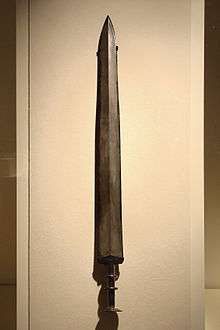
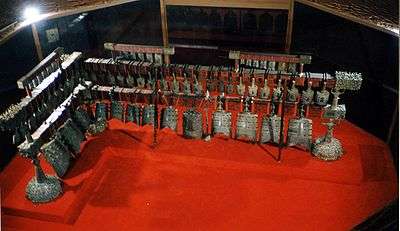
King Zhao was famous for repeated campaigns in the Yangtze areas and died in his last action. Later kings' campaigns were less effective. King Li led 14 armies against barbarians in the south, but failed to achieve any victory. King Xuan fought the Quanrong nomads in vain. King You was killed by the Quanrong when Haojing was sacked. Although chariots had been introduced to China during the Shang dynasty from Central Asia, the Zhou period saw the first major use of chariots in battle.[29][30] Recent archaeological finds demonstrate similarities between horse burials of the Shang and Zhou dynasties and Indo-European peoples in the west.[31] Other possible cultural influences resulting from Indo-European contact in this period may include fighting styles, head-and-hooves burials, art motifs and myths.[31]
Philosophy
During the Zhou dynasty, the origins of native Chinese philosophy developed, its initial stages beginning in the 6th century BC. The greatest Chinese philosophers, those who made the greatest impact on later generations of Chinese, were Confucius, founder of Confucianism, and Laozi, founder of Taoism. Other philosophers, theorists, and schools of thought in this era were Mozi, founder of Mohism; Mencius, a famous Confucian who expanded upon Confucius' legacy; Shang Yang and Han Fei, responsible for the development of ancient Chinese Legalism (the core philosophy of the Qin dynasty); and Xun Zi, who was arguably the center of ancient Chinese intellectual life during his time, even more so than iconic intellectual figures such as Mencius.[32]
Li
Established during the Western period, the Li (traditional Chinese: 禮; simplified Chinese: 礼; pinyin: lǐ) ritual system encoded an understanding of manners as an expression of the social hierarchy, ethics, and regulation concerning material life; the corresponding social practices became idealized within Confucian ideology.
The system was canonized in the Book of Rites, Zhouli, and Yili compendiums of the Han dynasty (206 BC–220 AD), thus becoming the heart of the Chinese imperial ideology. While the system was initially a respected body of concrete regulations, the fragmentation of the Western Zhou period led the ritual to drift towards moralization and formalization in regard to:
- The five orders of Chinese nobility.
- Ancestral temples (size, legitimate number of pavilions)
- Ceremonial regulations (number of ritual vessels, musical instruments, people in the dancing troupe)
Kings
The rulers of the Zhou dynasty were titled Wáng (王), which is normally translated into English as "king" and was also the Shang term for their rulers.[33] In addition to these rulers, King Wu's immediate ancestors – Danfu, Jili, and Wen – are also referred to as "Kings of Zhou", despite having been nominal vassals of the Shang kings.
NB: Dates in Chinese history before the first year of the Gonghe Regency in 841 BC are contentious and vary by source. Those below are those published by Xia–Shang–Zhou Chronology Project and Edward L. Shaughnessy's The Absolute Chronology of the Western Zhou Dynasty.
| Personal name | Posthumous name | Reign period | ||
|---|---|---|---|---|
| 發 | Fa | 周武王 | King Wu of Zhou | 1046–1043 BC 1045–1043 BC |
| 誦 | Song | 周成王 | King Cheng of Zhou | 1042–1021 BC 1042/1035–1006 BC |
| 釗 | Zhao | 周康王 | King Kang of Zhou | 1020–996 BC 1005/1003–978 BC |
| 瑕 | Xia | 周昭王 | King Zhao of Zhou | 995–977 BC 977/975–957 BC |
| 滿 | Man | 周穆王 | King Mu of Zhou | 976–922 BC 956–918 BC |
| 繄扈 | Yihu | 周共王/周龔王 | King Gong of Zhou | 922–900 BC 917/915–900 BC |
| 囏 | Jian | 周懿王 | King Yi of Zhou | 899–892 BC 899/897–873 BC |
| 辟方 | Pifang | 周孝王 | King Xiao of Zhou | 891–886 BC 872?–866 BC |
| 燮 | Xie | 周夷王 | King Yi of Zhou | 885–878 BC 865–858 BC |
| 胡 | Hu | 周厲王/周剌王 | King Li of Zhou | 877–841 BC 857/853–842/828 BC |
| 共和 | Gonghe Regency | 841–828 BC | ||
| 靜 | Jing | 周宣王 | King Xuan of Zhou | 827–782 BC |
| 宮湦 | Gongsheng | 周幽王 | King You of Zhou | 781–771 BC |
| End of Western Zhou / Beginning of Eastern Zhou | ||||
| 宜臼 | Yijiu | 周平王 | King Ping of Zhou | 770–720 BC |
| 林 | Lin | 周桓王 | King Huan of Zhou | 719–697 BC |
| 佗 | Tuo | 周莊王 | King Zhuang of Zhou | 696–682 BC |
| 胡齊 | Huqi | 周僖王 | King Xi of Zhou | 681–677 BC |
| 閬 | Lang | 周惠王 | King Hui of Zhou | 676–652 BC |
| 鄭 | Zheng | 周襄王 | King Xiang of Zhou | 651–619 BC |
| 壬臣 | Renchen | 周頃王 | King Qing of Zhou | 618–613 BC |
| 班 | Ban | 周匡王 | King Kuang of Zhou | 612–607 BC |
| 瑜 | Yu | 周定王 | King Ding of Zhou | 606–586 BC |
| 夷 | Yi | 周簡王 | King Jian of Zhou | 585–572 BC |
| 洩心 | Xiexin | 周靈王 | King Ling of Zhou | 571–545 BC |
| 貴 | Gui | 周景王 | King Jing of Zhou | 544–521 BC |
| 猛 | Meng | 周悼王 | King Dao of Zhou | 520 BC |
| 丐 | Gai | 周敬王 | King Jing of Zhou | 519–476 BC |
| 仁 | Ren | 周元王 | King Yuan of Zhou | 475–469 BC |
| 介 | Jie | 周貞定王 | King Zhending of Zhou | 468–442 BC |
| 去疾 | Quji | 周哀王 | King Ai of Zhou | 441 BC |
| 叔 | Shu | 周思王 | King Si of Zhou | 441 BC |
| 嵬 | Wei | 周考王 | King Kao of Zhou | 440–426 BC |
| 午 | Wu | 周威烈王 | King Weilie of Zhou | 425–402 BC |
| 驕 | Jiao | 周安王 | King An of Zhou | 401–376 BC |
| 喜 | Xi | 周烈王 | King Lie of Zhou | 375–369 BC |
| 扁 | Bian | 周顯王 | King Xian of Zhou | 368–321 BC |
| 定 | Ding | 周慎靚王 | King Shenjing of Zhou | 320–315 BC |
| 延 | Yan | 周赧王 | King Nan of Zhou | 314–256 BC |
Nobles of the Ji family proclaimed Duke Hui of Eastern Zhou as King Nan's successor after their capital, Chengzhou, fell to Qin forces in 256 BC. Ji Zhao, a son of King Nan, led a resistance against Qin for five years. The dukedom fell in 249 BC. The remaining Ji family ruled Yan and Wei until 209 BC.
Later tradition
Claimed descendants
The Han dynasty bestowed the hereditary title 周子南君 upon the Zhou dynasty royal descendant Ji Jia 姬嘉 and his descendants.[34] This practice was referred to as Two Kings, Three Reverences.
According to the New Book of Tang the Sui dynasty Emperors were patrilineally descended from the Zhou dynasty Kings via Ji Boqiao 姬伯僑, who was the son of Duke Wu of Jin.[35] Ji Boqiao's family became known as the "sheep tongue family" 羊舌氏.
The Yang of Hongnong 弘農楊氏[36][37][38][39][40] were asserted as ancestors by the Sui Emperors like the Longxi Li's were asserted as ancestors of the Tang Emperors.[41] The Li of Zhaojun and the Lu of Fanyang hailed from Shandong and were related to the Liu clan which was also linked to the Yang of Hongnong and other clans of Guanlong.[42] Duke Wu of Jin was claimed as the ancestors of the Hongnong Yang.[43] The Yang of Hongnong, Jia of Hedong, Xiang of Henei, and Wang of Taiyuan from the Tang dynasty were claimed as ancestors by Song dynasty lineages.[44] There were Dukedoms for the offspring of the royal families of the Zhou dynasty, Sui dynasty, and Tang dynasty in the Later Jin (Five Dynasties).[45]
The Zhou dynasty King Ling's son Prince Jin is assumed by most to be the ancestor of the Taiyuan Wang lineage.[46] The Longmen Wang were a cadet line of the Zhou dynasty descended Taiyuan Wang, and Wang Yan and his grandson Wang Tong hailed from his cadet line.[47] Both Buddhist monks and scholars hailed from the Wang family of Taiyuan such as the monk Tanqian.[48] The Wang family of Taiyuan included Wang Huan.[49] The Taiyuan Wang family produced Wang Jun who served under Emperor Huai of Jin.[50] A Fuzhou-based section of the Taiyuan Wang produced the Buddhist monk Baizhang.[51] During the Tang dynasty the Li family of Zhaojun 趙郡李氏, the Cui family of Boling 博陵崔氏, the Cui family of Qinghe 清河崔氏, the Lu family of Fanyang 范陽盧氏, the Zheng family of Xingyang 滎陽鄭氏, the Wang family of Taiyuan 太原王氏, and the Li family of Longxi 隴西李氏 were the seven noble families between whom marriage was banned by law.[52] Moriya Mitsuo wrote a history of the Later Han-Tang period of the Taiyuan Wang. Among the strongest families was the Taiyuan Wang.[53] The prohibition on marriage between the clans issued in 659 by the Gaozong Emperor was flouted by the seven families since a woman of the Boling Cui married a member of the Taiyuan Wang, giving birth to the poet Wang Wei.[54] He was the son of Wang Chulian who in turn was the son of Wang Zhou.[55] The marriages between the families were performed clandestinely after the prohibition was implemented on the seven families by Gaozong.[56] Their status as "Seven Great surnames" became known during Gaozong's rule.[57]
The Zhou dynasty Kings are the ancestors of the Zhou clan of Runan.
The Linghu of Dunhuang 敦煌令狐氏 were descended from King Wen of Zhou through his son Duke Gao of Bi 畢公高
The Zheng family of Xingyang 滎陽鄭氏 claim descent from the Zhou dynasty Kings via the rulers of the State of Zheng.
The Marquis of Xingyang rank was created for Zheng Xi.[58] The Xingyang Zheng spawned Zheng Daozhao and Zheng Xi.[59] Zheng Wanjun was a member of the Xingyang Zheng.[60] The Xingyang Zheng spawned Zheng Yuzhong (Zheng Qiao).[61] The Xingyang Zheng spawned Zheng Jiong.[62]
The Zheng of Xingyang may have been miswritten in the records as the Zheng of Xingyang 滎陽鄭氏.[63][64]
東野家族大宗世系 Family Tree of the descendants of the Duke of Zhou in Chinese
The main line of the Duke of Zhou's descendants came from his firstborn son, the State of Lu ruler Bo Qin's third son Yu (魚) whose descendants adopted the surname Dongye (東野). The Duke of Zhou's offspring held the title of Wujing Boshi (五經博士; 五經博士; Wǔjīng Bóshì).[65][66][67][68][69][70][71][72][73][74][75]
Duke Huan of Lu's son through Qingfu (慶父) was the ancestor of Mencius. He was descended from Duke Yang of the State of Lu 魯煬公 Duke Yang was the son of Bo Qin, who was the son of the Duke of Zhou. The genealogy is found in the Mencius family tree (孟子世家大宗世系).[76][77][78] Mencius's descendants were awarded the Wujing Boshi title.[65]
One of the Duke of Zhou's 72 generation descendants family tree was examined and commented on by Song Lian.[79]
Astrology
Zhou is represented by two stars, Eta Capricorni (週一 Zhōu yī, "the First Star of Zhou") and 21 Capricorni (週二 Zhōu èr, "the Second Star of Zhou"), in "Twelve States" asterism.[80] Zhou is also represented by the star Beta Serpentis in asterism "Right Wall", Heavenly Market enclosure (see Chinese constellation).[81]
See also
Notes
- ↑ Fenghao is the modern name for the twin city formed by the Western Zhou capitals of Haojing and Fēngjīng.
- ↑ The exact location of Wangcheng and its relation to Chengzhou is disputed. According to Xu Zhaofeng, "Chengzhou" and "Wangcheng" were originally synonymous and used to name the same capital city from 771 to 510 BC. "The creation of a distinction between Wangcheng and Chengzhou probably occurred during the reign of King Jing", under whom a new capital "Chengzhou" was built to the east of the old city "Wangcheng". Nevertheless, the new Chengzhou was still sometimes called Wangcheng and vice versa, adding to the confusion.[1]
- ↑ The exact location of Bin remains obscure, but it may have been close to Linfen on the Fen River in present-day Shanxi.[8][9]
- ↑ Sima Qian was only able to establish historical dates after the time of the Gonghe Regency. Earlier dates, like that of 1046 BC for the Battle of Muye, are given in this article according to the official PRC Xia–Shang–Zhou Chronology Project, but they remain contentious. Various historians have offered dates for the battle ranging between 1122 and 1027 BC.
- ↑ Bodman (1980), p. 41: "Moreover, Shang dynasty Chinese at least in its syntax and lexicon seems not to differ basically from that of the Zhou dynasty whose language is amply attested in inscriptions on bronze vessels and which was transmitted in the early classical literature."
References
Citations
- 1 2 3 4 5 "Considering Chengzhou ("Completion of Zhou") and Wangcheng ("City of the King")" (PDF). Xu Zhaofeng. Archived from the original (PDF) on July 22, 2015. Retrieved 22 July 2015.
- ↑ "Encyclopædia Britannica: Tian". Retrieved 17 August 2015.
- ↑ Schinz (1996), p. 80.
- 1 2 Shijing, Ode 245.
- ↑ "Hou Ji". Encyclopædia Britannica.
- ↑ Sima Qian. Records of the Grand Historian, Annals of Zhou, §3.
- ↑ Wu (1982), p. 235.
- ↑ Shaughnessy (1999), p. 303.
- ↑ Wu (1982), p. 273.
- ↑ David McCraw (2010). "An ABC Exercise in Old Sinitic Lexical Statistics" (PDF). Sino-Platonic Papers (202).
- ↑ Jessica Rawson, 'Western Zhou Archaeology,' in Michael Loewe, Edward L. Shaughnessy (eds.), The Cambridge History of Ancient China: From the Origins of Civilization to 221 B.C., Cambridge University Press 1999 pp.352-448 p.387.
- 1 2 Li, Feng (2006), Landscape And Power In Early China, Cambridge University Press, p. 286.
- ↑ Chiang, Po-Yi (1 Jan 2008). "Han Cultural and Political Influences in the Transformation of the Shizhaishan Cultural Complex". Australian National University: 1–2.
- ↑ Shaughnessy (1999), p. 310, 311.
- 1 2 Chinn (2007), p. 43.
- ↑ Hucker (1978), p. 32.
- ↑ Hucker (1978), p. 33.
- 1 2 Hucker (1978), p. 37.
- ↑ "The Steppe: Scythian successes". Encyclopædia Britannica Online. Retrieved 31 December 2014.
- ↑ .Carr, Brian & al. Companion Encyclopaedia of Asian Philosophy, p. 466. Taylor & Francis, 2012. ISBN 041503535X, 9780415035354.
- 1 2 3 L.,, Tignor, Robert. Worlds together, worlds apart. Adelman, Jeremy,, Aron, Stephen,, Brown, Peter, 1935-, Elman, Benjamin A., 1946-, Liu, Xinru,, Pittman, Holly, (Fourth edition, [Two volume edition] ed.). New York. ISBN 9780393922080. OCLC 870312289.
- 1 2 3 Shaw, Robert Tignor, Jeremy Adelman, Peter Brown, Benjamin Elman, Xinru Liu, Holly Pittman, Brent (2014). Worlds together, worlds apart (Fourth edition. ed.). p. 153. ISBN 978-0-393-92208-0.
- ↑ Brashier, K. E. (2011-01-01). Ancestral Memory in Early China. ISBN 9780674056077.
- ↑ The ramage system in China and Polynesia Li Hwei "Archived copy" (PDF). Archived from the original (PDF) on 2013-09-21. Retrieved 2013-05-13.
- ↑ Tao, Hsi-Sheng. Marriage and Family, Shanghai. 1934
- ↑ Ancestral Memory in Early China Written By K. E. Brashier https://books.google.com/books?id=aJAMLt5NYAQC&pg=PA71
- ↑ The Confucian Transformation of Korea: A Study of Society and Ideology Written By Martina Deuchler https://books.google.com/books?id=NQeeYOyUx64C&pg=PA129
- ↑ ChinaKnowledge.de encyclopedia, http://www.chinaknowledge.de/History/Zhou/zhou-admin.html.%5Bpermanent+dead+link%5D Alternatively, the sequence was translated as prince, lord, elder, master, chieftain: Brooks 1997:3 n.9.
- ↑ Ebrey, Walthall & Palais (2006), p. 14.
- ↑ Shaughnessy (1988).
- 1 2 Krech & Steinicke 2011, p. 100
- ↑ Schirokauer & Brown (2006), pp. 25–47.
- ↑ Thorp, Robert L. (2005). China in the Early Bronze Age. University of Pennsylvania Press. p. 176. ISBN 978-0-8122-3910-2.
- ↑ 《漢書‧楊胡朱梅雲傳》:初,武帝時,始封周後姬嘉為周子南君,至元帝時,尊周子南君為周承休侯,位次諸侯王。使諸大夫博士求殷後,分散為十餘姓,郡國往往得其大家,推求子孫,絕不能紀。時,匡衡議,以為「王者存二王后,所以尊其先王而通三統也。其犯誅絕之罪者絕,而更封他親為始封君,上承其王者之始祖。《春秋》之義,諸侯不能守其社稷者絕。今宋國已不守其統而失國矣,則宜更立殷後為始封君,而上承湯統,非當繼宋之絕侯也,宜明得殷後而已。今之故宋,推求其嫡,久遠不可得;雖得其嫡,嫡之先已絕,不當得立。《禮記》孔子曰:『丘,殷人也。』先師所共傳,宜以孔子世為湯後。」上以其語不經,遂見寢。
- ↑ New Book of Tang, zh:s:新唐書
- ↑ Howard L. Goodman (2010). Xun Xu and the Politics of Precision in Third-Century Ad China. BRILL. pp. 81–. ISBN 90-04-18337-X.
- ↑ Bulletin. The Museum. 1992. p. 154.
- ↑ Jo-Shui Chen (2 November 2006). Liu Tsung-yüan and Intellectual Change in T'ang China, 773-819. Cambridge University Press. pp. 195–. ISBN 978-0-521-03010-6.
- ↑ Peter Bol (1 August 1994). "This Culture of Ours": Intellectual Transitions in T?ang and Sung China. Stanford University Press. pp. 505–. ISBN 978-0-8047-6575-6.
- ↑ Asia Major. Institute of History and Philology of the Academia Sinica. 1995. p. 57.
- ↑ R. W. L. Guisso (December 1978). Wu Tse-T'len and the politics of legitimation in T'ang China. Western Washington. p. 242. ISBN 978-0-914584-90-2.
- ↑ Jo-Shui Chen (2 November 2006). Liu Tsung-yüan and Intellectual Change in T'ang China, 773-819. Cambridge University Press. pp. 43–. ISBN 978-0-521-03010-6.
- ↑ 《氏族志》
- ↑ Peter Bol (1 August 1994). "This Culture of Ours": Intellectual Transitions in T?ang and Sung China. Stanford University Press. pp. 66–. ISBN 978-0-8047-6575-6.
- ↑ Ouyang, Xiu (5 April 2004). Historical Records of the Five Dynasties. Richard L. Davis, translator. Columbia University Press. pp. 76–. ISBN 978-0-231-50228-3.
- ↑ Ding Xiang Warner (2003). A Wild Deer Amid Soaring Phoenixes: The Opposition Poetics of Wang Ji. University of Hawaii Press. pp. 156–. ISBN 978-0-8248-2669-7.
- ↑ Ding Xiang Warner (15 May 2014). Transmitting Authority: Wang Tong (ca. 584–617) and the Zhongshuo in Medieval China's Manuscript Culture. BRILL. pp. 98–. ISBN 978-90-04-27633-8.
- ↑ Jinhua Chen (2002). Monks and monarchs, kinship and kingship: Tanqian in Sui Buddhism and politics. Scuola italiana di studi sull'Asia orientale. pp. 34, 36. ISBN 978-4-900793-21-7.
- ↑ Oliver J. Moore (1 January 2004). Rituals Of Recruitment In Tang China: Reading An Annual Programme In The Collected Statements By Wang Dingbao (870-940). BRILL. pp. 35–. ISBN 90-04-13937-0.
- ↑ David R. Knechtges; Taiping Chang (10 September 2010). Ancient and Early Medieval Chinese Literature (vol.I): A Reference Guide, Part One. BRILL. pp. 544–. ISBN 90-04-19127-5.
- ↑ Steven Heine; Dale Wright (22 April 2010). Zen Masters. Oxford University Press. pp. 4–. ISBN 978-0-19-971008-9.
- ↑ http://history.berkeley.edu/sites/default/files/slides/Dissertation.pdf p. 67.
- ↑ A Zürcher (Milchfecker): Eine nicht alltägliche Stimme aus der Emmentaler-Käsereipraxis. Brill Archive. 1830. pp. 351–. GGKEY:WD42J45TCZZ.
- ↑ Wei Wang; Tony Barnstone; Willis Barnstone; Haixin Xu (1991). Laughing Lost in the Mountains: Poems of Wang Wei. UPNE. pp. xxvii–xxviii. ISBN 978-0-87451-564-0.
- ↑ Jingqing Yang (2007). The Chan Interpretations of Wang Wei's Poetry: A Critical Review. Chinese University Press. pp. 16–. ISBN 978-962-996-232-6.
- ↑ A Study of Yuan Zhen's Life and Verse 809--810: Two Years that Shaped His Politics and Prosody. ProQuest. 2008. pp. 65–. ISBN 978-0-549-80334-8.
- ↑ William H. Nienhauser (2010). Tang Dynasty Tales: A Guided Reader. World Scientific. pp. 78–. ISBN 978-981-4287-28-9.
- ↑ Ancient and Early Medieval Chinese Literature (vol.3 & 4): A Reference Guide, Part Three & Four. BRILL. 22 September 2014. pp. 2233–. ISBN 978-90-04-27185-2.
- ↑ Robert E. Harrist (2008). The landscape of words: stone inscriptions from early and medieval China. University of Washington Press. pp. 103, 117–118.
- ↑ Jinhua Chen (11 May 2007). Philosopher, Practitioner, Politician: the Many Lives of Fazang (643-712). BRILL. pp. 146–. ISBN 978-90-474-2000-2.
- ↑ Han Si (2008). A Chinese word on image: Zheng Qiao (1104-1162) and his thought on images. Acta Universitatis Gothoburgensis. pp. 31, 266. ISBN 978-91-7346-607-3.
- ↑ The Journal of the International Association of Buddhist Studies. International Association of Buddhist Studies. 1999. pp. 42, 39, 90.
- ↑ Bryan J. Cuevas; Jacqueline Ilyse Stone (2007). The Buddhist Dead: Practices, Discourses, Representations. University of Hawaii Press. pp. 264–. ISBN 978-0-8248-3031-1.
- ↑ James A. Benn (2007). Burning for the Buddha: Self-Immolation in Chinese Buddhism. University of Hawaii Press. pp. 304–. ISBN 978-0-8248-2992-6.
- 1 2 H.S. Brunnert; V.V. Hagelstrom (15 April 2013). Present Day Political Organization of China. Routledge. pp. 493–494. ISBN 978-1-135-79795-9.
- ↑ "Archived copy". Archived from the original on April 25, 2016. Retrieved May 20, 2016.
- ↑ Brunnert, I. S. (Ippolit Semenovich); Gagelstrom, V. V.; Kolesov, N. F. (Nikolai Fedorovich); Bielchenko, Andrei Terentevich; Moran, Edward Eugene. "Present day political organization of China". New York : Paragon – via Internet Archive.
- ↑ H.S. Brunnert; V.V. Hagelstrom (15 April 2013). Present Day Political Organization of China. Routledge. ISBN 978-1-135-79794-2.
- ↑ Qin ding da Qing hui dian (Jiaqing chao)0. 1818. pp. 1084–.
- ↑ 不詳 (21 August 2015). 新清史. 朔雪寒. pp. –. GGKEY:ZFQWEX019E4.
- ↑ Sturgeon, Donald. "曝書亭集 : 卷三十三 - 中國哲學書電子化計劃". ctext.org.
- ↑ "什么是 五经博士 意思详解 - 淘大白". www.taodabai.com. Archived from the original on 2016-06-23. Retrieved 2016-06-19.
- ↑ 王士禎 (3 September 2014). 池北偶談. 朔雪寒. pp. –. GGKEY:ESB6TEXXDCT.
- ↑ 徐錫麟; 錢泳 (10 September 2014). 熙朝新語. 朔雪寒. pp. –. GGKEY:J62ZFNAA1NF.
- ↑ "【从世袭翰林院五经博士到奉祀官】_三民儒家_新浪博客". blog.sina.com.cn.
- ↑ 《三遷志》,(清)孟衍泰續修
- ↑ 《孟子世家譜》,(清)孟廣均主編,1824年
- ↑ 《孟子與孟氏家族》,孟祥居編,2005年
- ↑ Thomas H. C. Lee (January 2004). The New and the Multiple: Sung Senses of the Past. Chinese University Press. pp. 337–. ISBN 978-962-996-096-4.
- ↑ (in Chinese)"AEEA – Astronomy Education Network (天文教育資訊網)" (in Chinese). July 4, 2006. Retrieved December 5, 2010.
- ↑ (in Chinese) "AEEA – Astronomy Education Network (天文教育資訊網)" (in Chinese). June 24, 2006. Retrieved December 5, 2010.
Works cited
- Beckwith, Christopher I. (16 March 2009). Empires of the Silk Road: A History of Central Eurasia from the Bronze Age to the Present. Princeton University Press. ISBN 1400829941. Retrieved 30 December 2014.
- Bodman, Nicholas C. (1980), "Proto-Chinese and Sino-Tibetan: data towards establishing the nature of the relationship", in van Coetsem, Frans; Waugh, Linda R., Contributions to historical linguistics: issues and materials, Leiden: E. J. Brill, pp. 34–199, ISBN 978-90-04-06130-9.
- Chinn, Ann-ping (2007), The Authentic Confucius, Scribner, ISBN 0-7432-4618-7
- Ebrey, Patricia Buckley; Walthall, Anne; Palais, James B. (2006), East Asia: A Cultural, Social, and Political History, Boston: Houghton Mifflin Company, ISBN 0-618-13384-4
- Gernet, Jacques (1996), A History of Chinese Civilization (Second ed.), Cambridge University Press, ISBN 0-521-49781-7
- Hucker, Charles O. (1978), China to 1850: A short history, Stanford University Press, ISBN 0-8047-0958-0
- Krech, Volkhard; Steinicke, Marian (2011). Dynamics in the History of Religions between Asia and Europe: Encounters, Notions, and Comparative Perspectives. Brill. ISBN 9004225358. Retrieved 30 December 2014.
- Khayutina, Maria (2003), "Where Was the Western Zhou Capital?" (PDF), The Warring States Working Group, WSWG-17, Leiden, Germany: Warring States Project, p. 14
- Kleeman, Terry F. (1998). Great Perfection: Religion and Ethnicity in a Chinese Millennial Kingdom. University of Hawaii Press. ISBN 0824818008. Retrieved 31 December 2014.
- Schinz, Alfred (1996). Axel Menges, ed. The Magic Square: Cities in Ancient China. Stuttgart, London: Daehan Printing & Publishing Co.
- Schirokauer, Conrad; Brown, Miranda (2006), A Brief History of Chinese Civilization (Second ed.), Wadsworth: Thomson Learning, pp. 25–47
- Shaughnessy, Edward L. (1988), "Historical Perspectives on The Introduction of The Chariot Into China", Harvard Journal of Asiatic Studies, 48 (1): 189–237, doi:10.2307/2719276, JSTOR 2719276
- Shaughnessy, Edward L. (1999), "Western Zhou History", in Loewe, Michael; Shaughnessy, Edward L., The Cambridge History of Ancient China, pp. 292–351, ISBN 978-0-521-47030-8
- Wu, K. C. (1982), The Chinese Heritage, New York: Crown Publishers, ISBN 0-517-54475-X
Further reading
- Fong, Wen, ed. (1980), The great bronze age of China: an exhibition from the People's Republic of China, New York: The Metropolitan Museum of Art, ISBN 978-0-87099-226-1.
- Lee, Yuan-Yuan; Shen, Sinyan (1999), Chinese Musical Instruments, Chinese Music Monograph Series, Chinese Music Society of North America Press, ISBN 978-1-880464-03-8.
- Li, Feng (2006), Landscape and Power in Early China: The Crisis and Fall of the Western Zhou 1045–771 BC, Cambridge University Press, ISBN 978-0-521-85272-2.
- Shen, Sinyan (1987), "Acoustics of Ancient Chinese Bells", Scientific American, 256 (4): 94, doi:10.1038/scientificamerican0487-104.
- Sun, Yan (2006), "Cultural and Political Control in North China: Style and Use of the Bronzes of Yan at Liulihe during the Early Western Zhou", in Mair, Victor H., Contact and Exchange in the Ancient World, Honolulu: University of Hawai'i Press, pp. 215–237, ISBN 978-0-8248-2884-4.
- Wagner, Donald B. (1999), "The Earliest Use of Iron in China", in Young, S. M. M.; Pollard, A. M.; Budd, P.; et al., Metals in Antiquity, Oxford: Archaeopress, pp. 1–9, ISBN 978-1-84171-008-2.
External links
| Wikimedia Commons has media related to Zhou Dynasty. |
- Chinese Text Project, Rulers of the Zhou period – with links to their occurrences in pre-Qin and Han texts.
| Preceded by Shang dynasty |
Dynasties in Chinese history 1046–256 BC |
Succeeded by Qin dynasty |